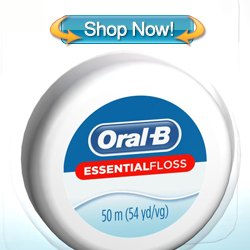Flossing
Flossing with braces can seem like a pretty tedious job, but it is really important, so don’t give up! You should floss every single day, preferably at bedtime after you have brushed your teeth. This will help remove any plaque left after brushing. If your gums aren’t healthy, they will probably bleed the first few days, but stick with it and the gum tissue will heal.
Flossing with braces is a little tricky at first but it gets easier with practice. A floss threader makes the job easier. There are also pre-cut lengths of floss you can buy that have a stiff “threader” end, eliminating the need for a separate floss threader. Figure out what works best for you. Either way, use the following technique:
- Thread your floss under the archwire that connects your braces together.
- Wrap the floss around the tooth on one side. Push the floss up towards the gum line, making sure the floss gets all the way under the gums, and then slide the floss down toward the wire. Be careful not to use too much force—you don’t want to bend your archwire! Slowly slide the floss up and down several times, right against the tooth, to remove all the plaque.
- Wrap the floss around the neighboring tooth and repeat the process.
- Once both teeth are flossed, pull out the floss and thread it between the next two teeth.
Interdental toothbrush
An interdental toothbrush (Proxabrush) can be very useful in cleaning under orthodontic wires and around the braces. Brush the tooth surface slowly and carefully so you do not damage your braces.
Antiseptic Rinse
After brushing and flossing, your orthodontist may recommend an antiseptic dental rinse to manage minor gum inflammation or mouth irritations from orthodontic appliances or canker sores, etc. Some antiseptic rinses also contain fluoride, providing extra protection against cavities.
Removable Appliances
If you are using a removable orthodontic appliance, it will accumulate food particles and plaque just like your teeth do. Every time you brush your teeth, brush your appliance. Once a day you should soak your appliance in a glass of water with a denture-cleaning tablet, such as Efferdent. (Use room temperature tap water; hot water could distort your appliance.) This will help prevent plaque buildup and oral infections and will keep your appliance tasting better.
Tips & Tricks
Put your time in front of the TV to good use! Sit down with your toothbrush (without toothpaste) and give your teeth and gums a thorough massage. You can do this while studying, or riding in the car, or anytime your hands are free. Spend up to 30 minutes a day doing this!
Also remember that anytime you eat, if you are unable to brush or floss, at least swish your mouth out with water. You can also carry toothpicks or small bristle brushes to help remove debris from your braces—just be gentle so you don’t damage your gums or your braces.
Regular Dental Checkups
Just because you are seeing your orthodontist regularly, doesn’t mean you can skip your regular dental visits! In fact, you will probably need to go more frequently than you did before. Many patients with braces continue to see their dentist every six months for a thorough examination, but increase visits with their dental hygienist to every three months for cleanings. Ask your hygienist how you are doing—if you have great oral hygiene you may not have to go as often, but if you have trouble keeping your teeth clean you may need to go even more frequently.
Be sure to read Part I: How to Brush


